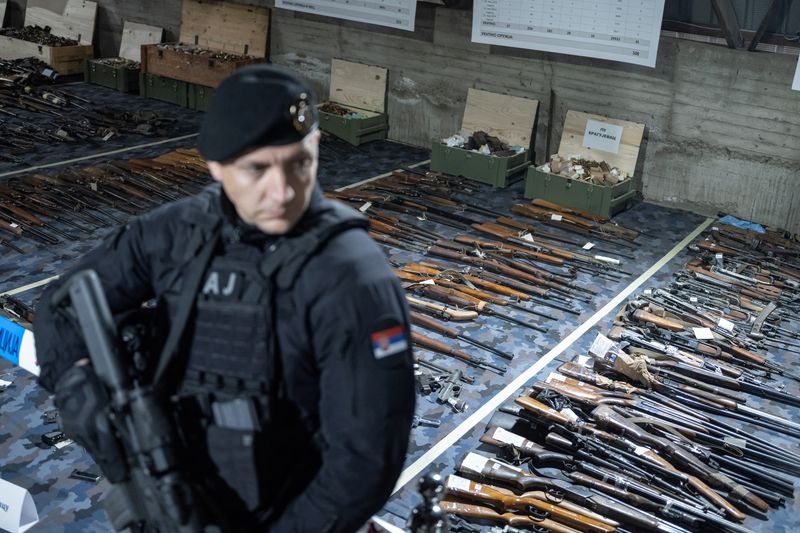Analysis-After two mass shootings, can Serbia rid itself of guns?
2023.05.22 11:40
5/5

© Reuters. A police officer stands guard in front of the weapons handed over to police in the first ten days of gun amnesty in police storage following mass shootings in the country, near Smederevo, Serbia, May 14, 2023. REUTERS/Marko Djurica
2/5
By Aleksandar Vasovic
BELGRADE (Reuters) – After Serbia was rocked by two mass shootings in two days earlier in May, Branko, 54, surrendered his unlicensed arms under a government amnesty: four assault rifles, nine handguns, eight grenades and many boxes of ammunition.
The huge cache of weapons handed over by just one veteran of the wars that tore apart Yugoslavia in the 1990s highlights the scale of the task facing the nation, where arms from a 19th century uprising against Ottoman rule and old British Bren machine guns parachuted to partisans in World War Two are also still hoarded.
“I surrendered my weapons as I was horrified at what happened,” said Branko – who asked to be identified by his old military callsign – referring to the May 3 shooting where a teenage pupil at a Belgrade school killed 10 people, and another the next day when a man killed eight in a village south of the capital.
Serbian President Aleksandar Vucic pledged to “practically disarm” his country, with the government quickly launching a month-long amnesty for illegal weapons.
More than 26,094 firearms, over 1.3 million rounds of ammunition and 6,333 pieces of ordnance had been handed in since May 8, interior ministry official Bojana Otovic Pjanovic told state TV RTS.
“There were weapons from 1847 and 1907, (old) English revolvers, a guidance system for anti-tank missiles, a fuse to which 4.6 kilograms of explosives were attached,” Pjanovic Otovic said.
Political opponents – who have long demanded tighter arms controls – call the move a populist step that cannot solve Serbia’s illegal weapons problem, while organising mass protests against the violence they say permeates society.
“This cannot be done quickly due to the estimated quantity of weapons …People here have no awareness about the dangers of holding illegal weapons,” said Jelena Jerinic, a law professor and a parliamentary deputy of the Ne Davimo Beograd opposition movement.
Many of the military grade weapons which flooded into Serbia and the rest of Western Balkans as Yugoslavia disintegrated ended up in private hands, turbocharging a culture of weapons ownership that Belgrade University history professor Aleksandar Zivotic describes as “ingrained in the (nation’s) foundations”.
Organised crime and various state-sponsored nationalist paramilitaries flourished during and after the wars, with dozens of people killed in gangland-style shootings until the early 2000s.
Authorities have struggled to assess the current scale of the problem. According to SEESAC, a UN and EU-backed regional gun-control initiative, the number of registered civilian firearms in Serbia increased almost 10% between 2012 and 2016 to 618,061. Officials’ estimates of unlicensed pieces range anywhere from 90,000 to 700,000.
Even in a country whose gun laws are tight by some European standards, Filip Svarm, editor in-chief of the Vreme weekly and a prominent analyst in the field, said it would take years for the state to disarm its citizens and he did not believe the amnesty and harsh sentences would solve the problem.
“The aggressiveness that is constantly fuelled in society affects some people in such a way that they now want to keep or get illegal guns,” he said.
SETTING AN EXAMPLE
Since May’s shootings, Vucic has halted issuance of new gun permits, tightened rules for existing owners and pledged changes to the law so it does not pay to keep illegal weapons.
It is not the first time the government has offered an amnesty – according to police data, 101,283 weapons and 2,517,520 rounds of ammunition were handed in between 2003 and 2017 – and it has already been steadily tightening requirements to legally hold a weapon. Opposition politicians, however, say enforcement can be lax.
Licensed gun owner Narcis Selimic, a marketing executive from Belgrade who has a 11-year-old son, was among those giving up his pistol, bought for personal protection in the 1990s, under the current amnesty.
“Because of this event in the school, I decided to…set an example to my friends,” he said.
Prices of illegal weapons on the 1990s black market in Serbia were as low as $10 for a hand grenade and $150 for an assault rifle, and many were smuggled outside the country.
Nils Duquet, director of the Flemish Peace Institute, advocates a regional approach given the high number of weapons also found in neighbouring countries.
Serbia, along with Montenegro, has the highest estimated number of civilian firearms per 100 residents in Europe according to the 2018 Small Arms Survey, a Switzerland-based research project, at 39.1 per 100 residents.
Between 2012 and 2016 Serbia registered a total of 10,061 gun-related crimes, neighbouring Albania 6,815 and Bosnia 5,616, SEESAC’s data shows.
Duquet said that while the situation in Serbia was not comparable to the United States, which has far more frequent mass shootings, the country’s latest attempt to disarm may form a useful precedent closer to home as war rages again in Europe.
“In the future we will likely have a similar problem in Ukraine,” he said.








